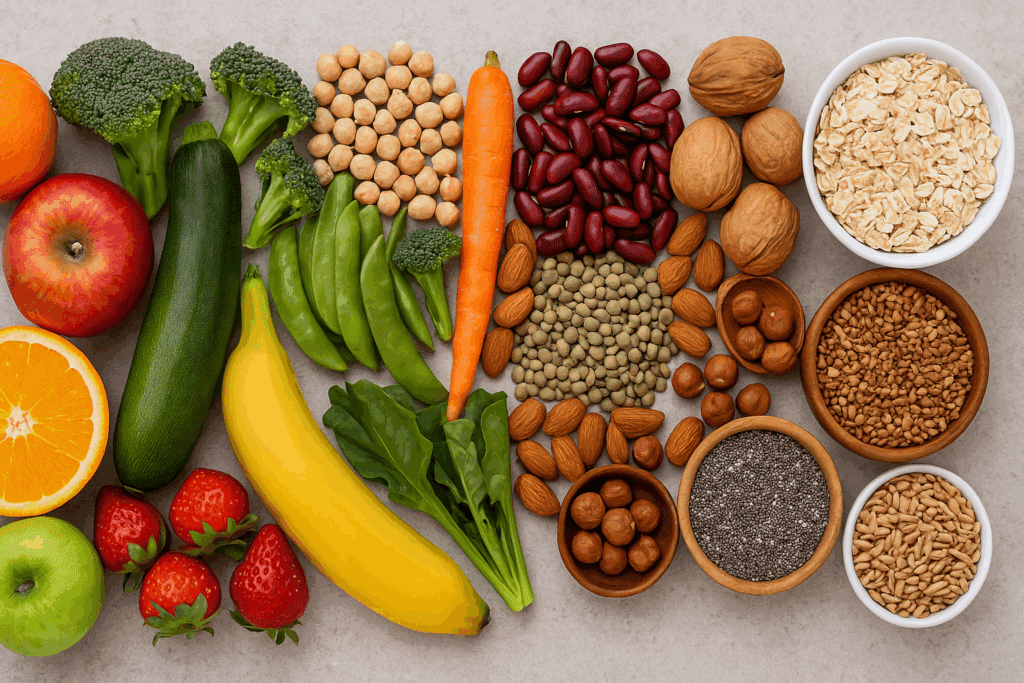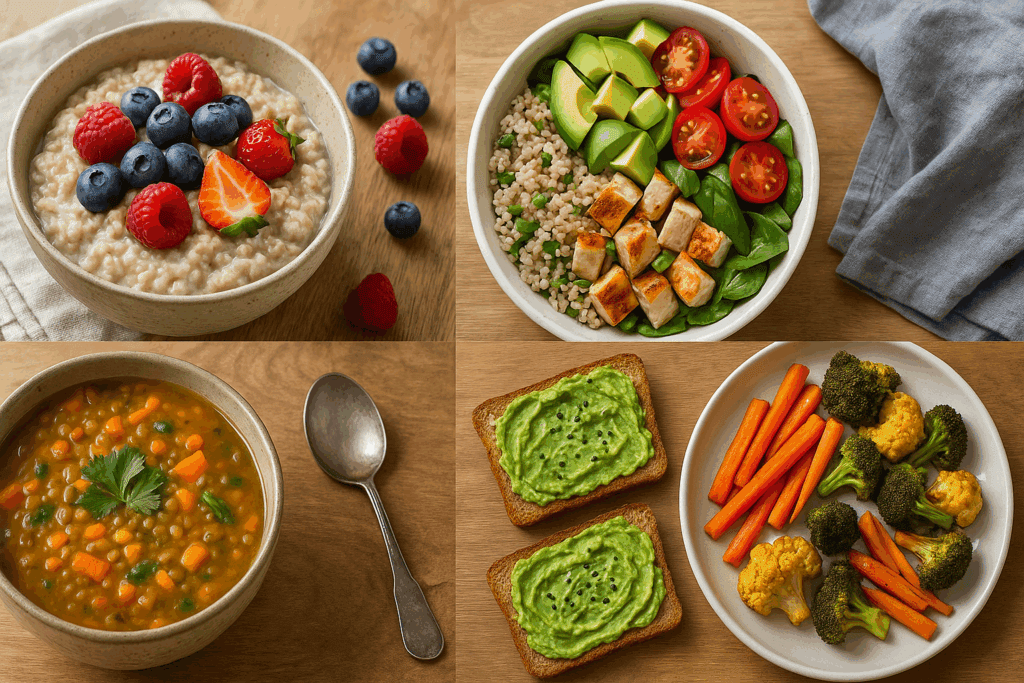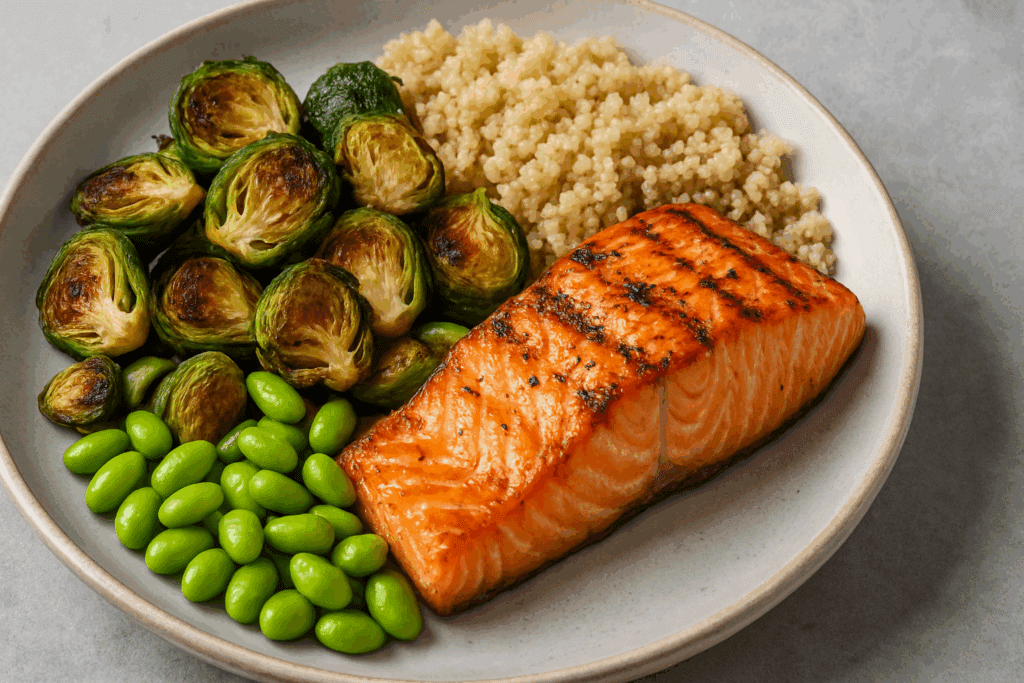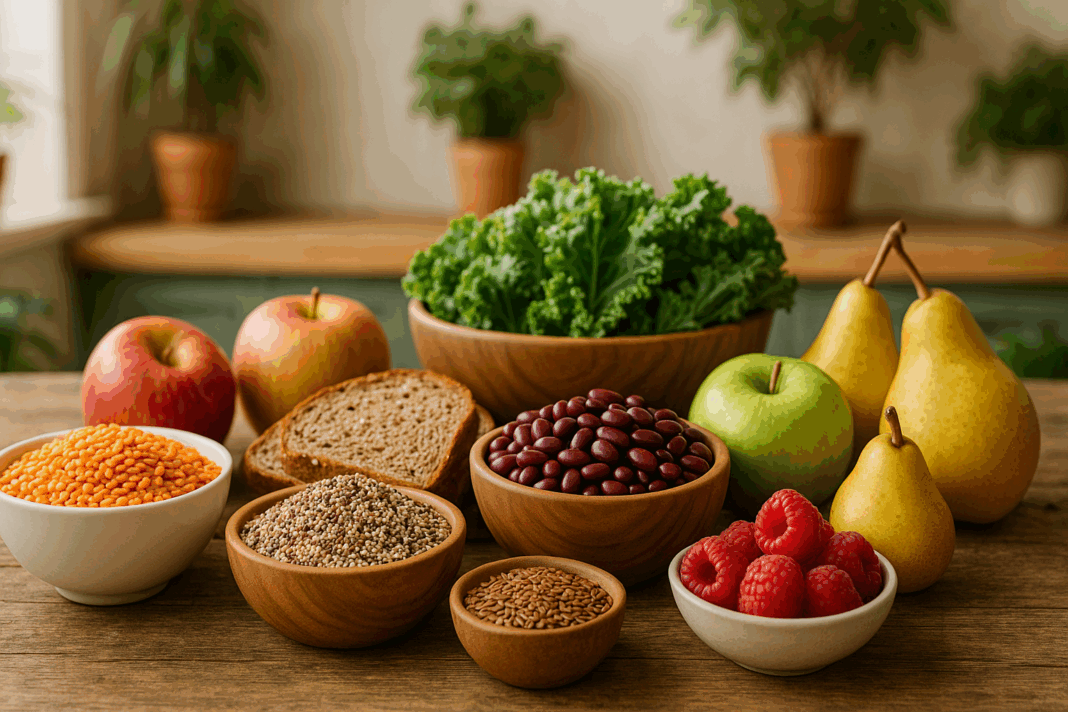Fiber plays a critical role in maintaining digestive wellness, yet many people struggle with understanding how to get more fiber in your diet in ways that feel effortless and sustainable. With growing awareness of gut health and the rising popularity of holistic supplements, there’s no better time to explore how fiber-rich nutrition supports overall well-being. This guide dives deep into the science, strategies, and everyday practices that can transform the way you approach fiber, offering a practical yet comprehensive view suitable for anyone aiming to improve their diet naturally and effectively.
You may also like: The Ultimate Guide to Gut Healthy Meals: Best Meals for Gut Health and Nourishing Recipes You’ll Love

Understanding What Fiber Is and Why It Matters for Gut Health
Fiber is a type of carbohydrate that the body cannot digest. Unlike simple sugars or refined starches, fiber passes through the digestive tract mostly intact, providing crucial support to intestinal flora and promoting healthy bowel movements. There are two primary types of fiber: soluble and insoluble. Soluble fiber dissolves in water to form a gel-like substance that can help lower cholesterol and stabilize blood sugar. Insoluble fiber adds bulk to stool and helps food pass more efficiently through the digestive system.
But what does fiber do beyond digestive support? Fiber serves as a prebiotic, feeding the beneficial bacteria in the gut and enhancing the microbiome—a key player in immune function, mood regulation, and even metabolic health. By including high fiber foods in your diet consistently, you contribute to a diverse gut microbiota, which is associated with reduced risk of chronic disease. Understanding what is fiber, therefore, is the first step in making conscious choices that improve your health from the inside out.
How Much Fiber Per Day Is Needed for Optimal Health?
A frequent question among health-conscious individuals is how much fiber per day is necessary to support digestive health. Current dietary guidelines recommend a daily intake of about 25 grams for women and 38 grams for men. However, most people fall short, often consuming less than 15 grams per day. This discrepancy can be attributed to diets that are high in processed foods and low in whole fruits, vegetables, legumes, and whole grains.
Knowing how much fiber do you need a day isn’t just about hitting a number. It’s about ensuring consistency and variety in your fiber intake. High fiber meals that include both soluble and insoluble sources contribute to better digestive flow and nutrient absorption. Eating an array of fiber rich vegetables and fruits, along with fiber rich snacks throughout the day, ensures that you meet the fiber threshold while also obtaining a wide spectrum of vitamins and phytonutrients.

What Foods Have Fiber and Why Diversity Matters
One of the most common yet important questions in nutrition is: what foods have fiber? A broad spectrum of foods offers fiber, including vegetables, fruits, legumes, nuts, seeds, and whole grains. Within these categories, certain choices stand out for their exceptionally high fiber content. For example, lentils, black beans, and chickpeas are excellent high protein high fiber foods that also offer valuable plant-based nutrients. Oats, barley, and quinoa provide soluble fiber along with complex carbohydrates.
When exploring what fruits contain fiber, consider apples, pears, raspberries, and avocados as standouts. The high fiber vegetables list includes broccoli, Brussels sprouts, artichokes, carrots, and leafy greens. Variety is key when considering how to increase fiber in your diet because different plant-based foods support different microbial populations within the gut. Incorporating a range of high fiber low sugar, high fiber low fat foods ensures a balance that supports not only digestive regularity but also heart and metabolic health.

How to Get More Fiber in Your Diet Naturally and Effectively
Integrating more fiber into your daily eating habits doesn’t require an extreme dietary overhaul. Learning how to get more fiber in your diet can be a matter of small, sustainable changes. Begin by swapping white rice and pasta for brown rice, quinoa, or whole grain alternatives. Incorporate beans into soups, salads, and stews to boost both protein and fiber intake. Add ground flaxseeds or chia seeds to smoothies and oatmeal for a quick fiber boost without altering the flavor.
When it comes to fiber rich snacks, opt for raw vegetables with hummus, roasted chickpeas, or a handful of almonds. Good fiber snacks that are both convenient and satisfying can be the key to maintaining steady fiber intake throughout the day. For breakfast, choose high fiber meals such as oatmeal topped with berries and nuts or whole grain toast with avocado. Many people ask, is 8 g of fiber good for breakfast? In most cases, aiming for 7 to 10 grams of fiber in your morning meal can set a solid foundation for the day. Understanding how much is a healthy amount of fiber for breakfast can help distribute intake evenly.
Exploring the High Fiber Vegetables List for Better Gut Health
Vegetables are some of the most nutrient-dense, fiber-rich foods available. When examining a high fiber vegetables list, it becomes evident that these plant-based options provide a unique combination of fiber, antioxidants, and water content that makes them invaluable for gut health. Artichokes, for example, are not only rich in inulin, a prebiotic fiber, but also support bile production for better fat digestion. Carrots and sweet potatoes offer a mix of soluble and insoluble fiber while delivering beta carotene, an antioxidant crucial for cellular repair.
Leafy greens such as kale, spinach, and collard greens are also essential players. Not only are they part of any solid high fibre foods table, but they are incredibly low in calories and rich in nutrients. Including them in salads, sautés, or smoothies is a powerful strategy for increasing fiber intake without overloading on calories. By focusing on variety and preparation, you can create high fiber low calorie meals that satisfy your hunger while nourishing your gut.

What Fruits Have the Most Fiber and Why They Matter
Fruits not only add sweetness and flavor to meals but also play a vital role in maintaining digestive balance. Knowing what fruits have the most fiber can help you make smarter choices throughout the day. Raspberries lead the pack, offering over 8 grams of fiber per cup, followed by pears, apples with skin, bananas, and figs. These options are especially beneficial when consumed in whole form rather than juice, which removes much of the fiber.
By eating a colorful array of fruit, you support different aspects of digestion and blood sugar control. Soluble fiber in fruits slows the absorption of sugar, helping to avoid spikes in glucose levels. Insoluble fiber, found in skins and peels, promotes efficient waste elimination. For those asking what fruits contain fiber, it’s helpful to remember that even citrus fruits like oranges and grapefruit contribute meaningful fiber when consumed with the membrane intact. Dried fruits such as prunes, apricots, and dates also provide concentrated sources of fiber but should be consumed in moderation due to their higher sugar content.
Designing a High Fiber Diet Menu for Holistic Gut Health
Crafting a high fiber diet menu involves more than just adding a few extra vegetables to your plate. It requires a thoughtful approach to meal planning that emphasizes balance, diversity, and nutrient synergy. Begin each day with a fiber-rich breakfast such as steel-cut oats topped with sliced banana, chia seeds, and a dollop of almond butter. For lunch, a quinoa and black bean salad with mixed greens and roasted vegetables offers a powerful combination of fiber, protein, and antioxidants.
Dinner can be centered around high fiber vegan foods like lentil curry with brown rice or a vegetable stir-fry with tofu and edamame. These high fiber meals are not only filling but also deeply nourishing. Snacks can include high fiber low sugar options like celery sticks with almond butter or unsweetened coconut yogurt with ground flax. When building a high fiber diet menu, it’s important to ensure that meals are both enjoyable and sustainable. This approach supports long-term adherence, which is critical for lasting gut health benefits.

High Protein High Fiber Foods: The Dual Benefit for Digestion and Metabolism
Combining fiber with protein is a strategic way to enhance both satiety and metabolic efficiency. High protein high fiber foods help regulate appetite, support lean muscle mass, and provide extended energy throughout the day. Lentils, chickpeas, edamame, and black beans are standout examples of plant-based options that check both boxes. Animal proteins like salmon and chicken can be paired with fiber-rich sides like roasted Brussels sprouts or a spinach salad topped with avocado.
This dual approach also supports balanced blood sugar levels and can contribute to weight management efforts. By integrating what foods have fiber and protein into each meal, you reduce the likelihood of energy crashes and unnecessary snacking. Fiber slows the digestion of protein, resulting in a slower release of glucose into the bloodstream. This synergy is particularly important for individuals managing conditions like diabetes or metabolic syndrome.
High Fiber Foods for Weight Loss and Digestive Efficiency
Fiber is a silent powerhouse when it comes to weight management. By adding bulk to meals without adding calories, high fiber foods promote a feeling of fullness that can prevent overeating. Additionally, fiber-rich meals often require more chewing and slower consumption, which contributes to better portion control. The fermentation of fiber in the colon also produces short-chain fatty acids that may influence hormones related to appetite.
High fiber foods for weight loss include legumes, whole grains, and fibrous vegetables like zucchini, cauliflower, and cabbage. Swapping out low fiber, high-calorie snacks for good fiber snacks such as air-popped popcorn or roasted edamame can make a meaningful difference in caloric intake without compromising satiety. For those pursuing a high fiber low fat, high fiber low calorie approach, the key is to focus on foods that are naturally nutrient-dense and minimally processed.
How to Increase Fiber Without Digestive Discomfort
As beneficial as fiber is, increasing intake too rapidly can lead to bloating, gas, or cramping. To avoid these issues, it’s important to gradually incorporate more fiber into your meals over the course of a few weeks. Drinking plenty of water is also essential, as fiber absorbs moisture and requires fluid to move through the digestive tract smoothly.
Start by adding fiber rich snacks between meals and slowly transition to higher fiber options at breakfast and lunch. Cooking vegetables can also reduce their fiber density slightly, making them easier to digest while still providing important nutrients. If you are wondering how to increase fiber without overwhelming your system, focus on small, consistent changes rather than dramatic shifts. Over time, your gut microbiota will adapt, and fiber tolerance will improve.
Evaluating Fiber Supplements vs. Whole Foods
While fiber supplements can be helpful in certain cases, such as during travel or illness, they should not replace fiber-rich whole foods as a long-term strategy. Whole foods offer additional vitamins, minerals, and antioxidants that are not present in isolated fiber powders or pills. Moreover, they contribute to dietary variety, which is essential for a healthy microbiome.
For individuals with specific conditions such as irritable bowel syndrome or diverticulitis, certain types of fiber may be better tolerated than others. In these cases, working with a registered dietitian or healthcare provider can help determine whether supplementation is appropriate. Nonetheless, when exploring how to get more fiber in your diet, starting with food-based options is almost always the most effective and sustainable approach.
Frequently Asked Questions: The Essential Guide to High Fiber Foods and Gut Health
What are some lesser-known high fiber foods that can diversify my diet?
While common fiber foods like beans, oats, and broccoli often top the charts, there are several underrated sources worth exploring. Jerusalem artichokes, also known as sunchokes, contain inulin, a unique prebiotic fiber that fuels beneficial gut bacteria. Tiger nuts, a root vegetable despite their name, are a chewy snack packed with resistant starch. Green plantains, when prepared properly, offer both soluble and insoluble fiber and can be used in savory or sweet dishes. Another surprising addition is freekeh, an ancient grain rich in fiber and protein that adds a nutty depth to salads or grain bowls. These alternatives not only expand your high fiber diet menu but also introduce new textures and flavors to keep meals interesting.
How to Get More Fiber in Your Diet Without Overeating or Feeling Bloated?
One of the challenges with increasing fiber intake is the initial discomfort that some people experience. To avoid bloating, start by gradually incorporating high fiber foods like lentils, chia seeds, and berries in small portions. Spread your fiber intake throughout the day rather than consuming large amounts in one meal. Pair fiber rich vegetables with water-rich foods like cucumber or oranges, which can aid digestion. It’s also helpful to engage in light physical activity after meals to stimulate intestinal movement and reduce discomfort. Using cooked versions of certain vegetables like carrots or spinach can also ease digestion while preserving their place on the high fiber vegetables list.
Are There Any Social or Cultural Factors That Influence Fiber Consumption?
Yes, dietary patterns shaped by culture often influence how much fiber per day people consume. For example, Mediterranean diets emphasize legumes, leafy greens, and whole grains—staples that naturally contain fiber. In contrast, Western diets tend to include more processed and refined foods, which are low in fiber. Societal norms around convenience and fast food also hinder the intake of good fiber snacks and high fiber meals. Introducing traditional dishes that use high fiber low fat foods, such as lentil soups or bean stews, can be an effective way to integrate cultural familiarity with gut-friendly nutrition. Understanding these dynamics helps tailor personalized strategies for how to get more fiber in your diet in ways that feel authentic and sustainable.
What Is the Connection Between Fiber and Mental Health?
Emerging research suggests that fiber-rich diets can positively influence mental well-being through the gut-brain axis. High fiber foods, especially those that contain prebiotic fiber like garlic, onions, and bananas, foster a healthier gut microbiome. This microbial balance plays a role in producing neurotransmitters such as serotonin, which affect mood and cognition. Some studies have linked diets rich in high fiber low sugar options with reduced symptoms of depression and anxiety. By learning what does fiber do beyond digestion, individuals can recognize its impact on broader aspects of health, including mental clarity and emotional regulation.
How to Get More Fiber in Your Diet If You Follow a Vegan or Plant-Based Lifestyle?
Those adhering to plant-based diets are uniquely positioned to exceed recommended fiber intake by focusing on high fiber vegan foods. Incorporate pulses like split peas, mung beans, and black-eyed peas into soups, salads, and main dishes. Tempeh and tofu, while primarily protein sources, also contribute small amounts of fiber and are often paired with high fiber vegetables. Add texture and variety with fiber rich snacks like trail mixes made from pumpkin seeds, dried apricots, and coconut flakes. Many vegans benefit from tracking their meals with a high fibre foods table to ensure diversity and completeness. These practices make it easier to determine how much fiber do you need a day based on personal health goals and lifestyle.
Is 8 g of Fiber Good for Breakfast, and How Should It Be Distributed Throughout the Day?
An 8-gram fiber breakfast is generally considered a strong start to the day. How much is a healthy amount of fiber for breakfast can vary, but aiming for 7 to 10 grams allows for more consistent distribution across meals. Combine oats with berries and ground flaxseed, or whole grain toast with avocado and spinach, to achieve this goal. Balancing each meal with fiber rich components—not just breakfast—helps maintain steady energy and prevents digestive overload. Remember that fiber works best when consumed in balance throughout the day, so factor in fiber rich snacks and high fiber low calorie options during lunch and dinner.
Can Fiber Improve Athletic Performance or Recovery?
While not traditionally associated with sports nutrition, fiber can contribute to performance indirectly. A high fiber diet menu improves metabolic health, blood sugar control, and inflammation—factors that influence endurance and recovery. High protein high fiber foods such as quinoa with edamame or chickpea pasta with vegetables offer both muscle-building and gut-supportive benefits. Fiber also stabilizes post-workout appetite, reducing the urge for nutrient-poor snacking. Including high fiber low fat meals can promote lean muscle mass while keeping digestive health in check. Athletes who often ask how to increase fiber without affecting training should introduce fiber gradually and avoid high loads before intense exercise.
What Are Some Common Myths About High Fiber Foods and Their Role in Weight Management?
One myth is that all high fiber foods are low in calories or inherently healthy for weight loss. While fiber does aid in satiety and slows digestion, some fiber foods like granola or processed energy bars may be high in added sugar or fat. Understanding the difference between whole food sources and packaged options is key to creating effective high fiber meals. Another misconception is that rapid weight loss is guaranteed with increased fiber. In reality, high fiber foods for weight loss should be part of a balanced approach that includes physical activity and hydration. Paying attention to what foods have fiber and protein, like lentils and nuts, also supports sustainable weight management without depriving the body.
How Can Busy Professionals or Students Eat More Fiber Without Extensive Meal Prep?
Time constraints often lead people to skip meals or reach for processed options low in fiber. To avoid this, consider batch-cooking high fiber meals like lentil chili or barley soup over the weekend. Keep frozen high fiber vegetables like spinach, peas, and artichoke hearts on hand for quick sautés. Pack portable good fiber snacks such as roasted chickpeas, fruit-and-nut bars, or air-popped popcorn. If you’re wondering how to get more fiber in your diet on a tight schedule, having pre-prepped ingredients and simple recipes ready to go makes a significant difference. With just a little planning, you can easily hit your target for how much fiber daily intake you need.
What Tools or Resources Can Help Track and Improve Fiber Intake?
Several digital tools make fiber tracking more manageable. Apps like Cronometer, MyFitnessPal, and MyNetDiary allow users to log meals and analyze nutrient breakdown, including how much fiber per day is consumed. Some platforms even offer customizable goals based on age, gender, and activity level. A printable high fibre foods table or gut health journal can also provide visual cues and motivation. Additionally, integrating smart kitchen devices like digital scales and fiber-friendly cookbooks can streamline your high fiber diet menu. By using these tools, users can identify gaps in their fiber intake and adjust in real time, especially when exploring what foods have fiber and how to increase fiber with minimal guesswork.
Final Thoughts on Achieving Optimal Gut Health with Fiber-Rich Foods
Gut health is intricately linked to every aspect of wellness, from immune function and energy levels to mood and metabolism. One of the most effective ways to nurture your digestive system is by understanding how to get more fiber in your diet naturally and intentionally. By prioritizing high fiber foods such as legumes, whole grains, fruits, and vegetables, you lay the groundwork for a diverse and resilient gut microbiome.
This guide has shown that learning how much fiber daily is ideal, identifying what foods have fiber, and crafting high fiber meals doesn’t have to be complicated or restrictive. It is a practice of mindful nourishment, grounded in scientific understanding and daily habit formation. Whether you’re focused on weight management, metabolic health, or simply enhancing your digestive resilience, integrating fiber into your lifestyle is a powerful step toward holistic wellness. Continue exploring, experimenting, and enjoying the journey to better gut health—one fiber-rich bite at a time.
Further Reading:
Foods high in fiber: Boost your health with fiber-rich foods

